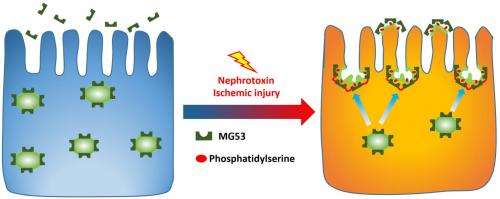Researchers identify protein needed for repair of injured kidney cells

Cardiovascular researchers at The Ohio State University Wexner Medical Center have shown that a protein known as MG53 is not only present in kidney cells, but necessary for the organ to repair itself after acute injury. Results from this animal model study are published in the journal Science Translational Medicine.
Previous work by Jianjie Ma, a professor and researcher in Ohio State's Department of Surgery and the Dorothy M. Davis Heart & Lung Research Institute, identified and proved that MG53 repairs heart, lung and skeletal muscle cells as well.
"MG53 is a key component of cellular self-repair. Identification of MG53 as a vital component of reno-protection could lead to new preventive or therapeutic treatments for acute kidney failure," Ma said.
Acute kidney injury (AKI) is common because the kidneys can be stressed by various medical conditions and treatments, including sepsis, open-heart surgery, chemotherapy, contrast agents and medications that are toxic to the kidneys. If AKI is not treated at the early stage, the condition becomes chronic kidney disease, which currently affects more than 30 million Americans.
Ma's research team compared normal renal cells to those that lacked MG53. After mechanical injury, normal cells survived, while cells lacking MG53 quickly died. When MG53 was restored, it increased the survival of the cells with no negative side effects. Ma said this illustrates the protein's role in cell membrane repair.
The team also showed that intravenous application of MG53 can protect the kidney from ischemia reperfusion, which is the tissue damage that occurs when blood supply is restored after a lack of oxygen. Ma said this could lead to preventive treatment before medical procedures that are known to stress the kidneys.
"We know patients who have cardiothoracic surgery are at high risk for developing acute kidney injury, in fact about a third of patients do. The possibility of lowering that risk with a preventive treatment like this is promising," said Dr. Robert Higgins, chair of The Ohio State University Department of Surgery.
In the study, similar protective properties were observed when used with cisplatin, a chemotherapy agent widely used to treat cancer. This protection did not affect the drug's key tumor suppressing function. Ma believes MG53 could potentially be used to protect renal function during chemotherapy for cancer patients.
The team is currently testing the efficacy of this treatment in large animal models.
More information: MG53-mediated cell membrane repair protects against acute kidney injury, stm.sciencemag.org/lookup/doi/ … scitranslmed.3010755
















